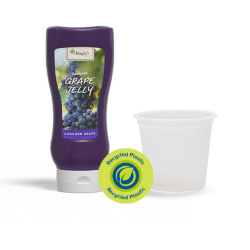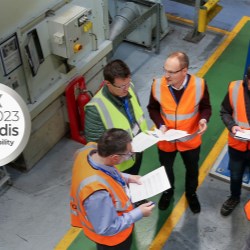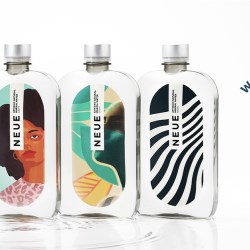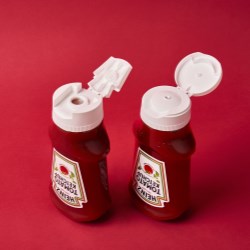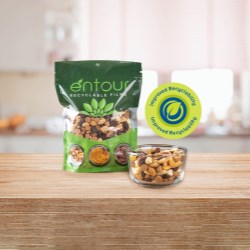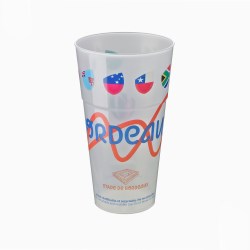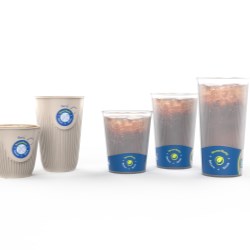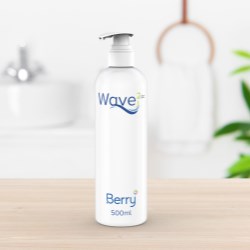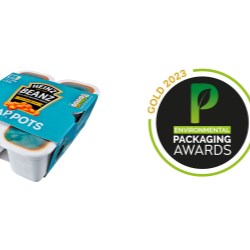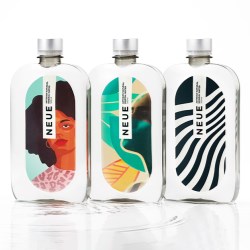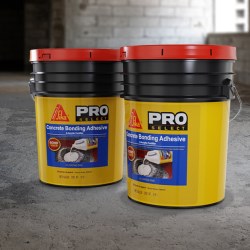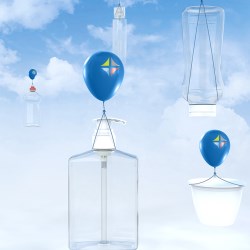

With a growing demand among consumers for fresh, unprocessed foods and beverages, customers in the food industry are looking to safely preserve their products without the use of harsh preservatives.
While chemical and thermal processing offers the necessary protection for products containing preservatives, preservative- free products such as meat, fish, poultry, dairy, and more require alternative protection methods. When combined with the right packaging solution, High Pressure Processing (HPP) enables the preservation of foods and beverages without harsh preservatives, allowing brands to clean up their labels, extend product shelf-life, reduce food waste, and more.
How does HPP Work?
High pressure processing (HPP) ironically isn’t really processing at all. HPP is a non-thermal food preservation method that utilizes cold water and extreme pressure (up to 87,000 psi) to inactivate food-borne pathogens and spoilage organisms.
The effectiveness of HPP depends on the amount of pressure applied, vessel holding time, temperature, product type, and targeted pathogens and spoilage organisms. These HPP parameters will differ based on product type and desired result (e.g., food safety, shelf-life extension, etc.).
Unlike chemical and thermal food safety methods that can compromise flavor, vitamins, and nutrients, HPP is a non-thermal and non-chemical process. Without the use of heat, the product’s original qualities are more likely to remain intact. Also, because water pressure is applied uniformly in all directions, HPP foods typically retain their original shape and are not crushed.
What are the Benefits of HPP?
HPP offers numerous benefits that help strengthen the consumer experience and build brand equity, including:
Improved Food Safety
By disrupting foodborne pathogens within their final sealed packaging, HPP reduces the risk of recontamination before the product is sold.
Pathogenic vegetative bacteria types disrupted by HPP:
- Salmonella
- E. coli 0157:H7
- Listeria monocytogenes
- (Lm) Campylobacter
- Vibrio in shellfish
Shelf-Life Extension
Because HPP disrupts the growth of bacterial and spoilage organisms (yeasts and mold), it typically doubles the shelf life of refrigerated products.
Cleaner Label Products
Since HPP uses only water and pressure, there is no need for the use of harsh chemicals to kill bacteria or added sodium or nitrates to preserve freshness. HPP helps simplify the ingredient list of the final product.
Brand Protection
HPP provides a level of defense against product recalls caused by pathogen contamination, reducing the risk of foodborne illness.
Competitive Differentiation
Due to increased shelf life, cleaner labels, and product innovation, HPP helps facilitate a competitive advantage for manufacturers and retailers. For instance, HPP enables manufacturers and brands to transition from frozen foods to fresh, ready-to-eat products.
Logistical Advantages
With a longer shelf life, manufacturers may gain wider distribution ranges. This can reduce the amount of food wasted from spoilage for both retailers and consumers.
Better Organoleptics (Taste, Texture, Color)
Because HPP uses only water and pressure, many natural qualities and characteristics of HPP products may be preserved longer. The absence of heat treatment allows foods and beverages to remain at their peak taste, texture, and color for a longer period of time.
Innovative New Products
HPP can preserve the characteristics of reformulated products, such as low sodium meats. It can also improve the creaminess of yogurt-based products, all while keeping foods fresh.
What are the Packaging Considerations for HPP?
Before applying HPP to food and beverage containers, there are several packaging considerations that must be addressed to ensure your containers are compatible with HPP technology and achieve your unique branding expectations.
HPP Container Requirements
High Durability
Plastics are one of the best choices for packaging due to their ability to survive extreme pressure and rigorous handling. The intense pressure squeezes the package, so it must be able to bounce back without cracking or breaking. The container can be made from a variety of plastics including polypropylene (PP), high density polyethylene (HDPE), and polyethylene terephthalate (PET), and can be any color.
When comparing PP and PET specifically, PP typically performs slightly better in drop testing compared to PET containers* and can be filled at slightly higher temperatures. Polypropylene also possesses unique properties that allow PP containers to be used or reused multiple times and to withstand microwaving and dishwashing.
Strong Seal
The film used in HPP must maintain a high burst strength, yet still be peelable for the consumer. Films can be made out of many types of plastic; one of the most important factors is to be compatible with the container material. For example, a PP film must be paired with a PP container. The container must be able to accept a film seal and should not have any types of coating on it that hinder that sealing process. The bond between the film and container should be strong and secure.
Minimal Head Space
Minimizing head space in the container is important for HPP. A general rule is to fill the container at least 90% or higher to head space inside the container. If there is too much air in a container, it could cause excess stress on the container and result in bursting or cracking. It is important to test any container and film with your specific product before using.
Selecting the Right Container
Material
Two of the most common rigid packaging materials used for HPP that are also highly prevalent in rigid package portfolios are #1 PET (polyethylene terephthalate) and #5 PP (polypropylene). In fact, there’s a good chance that you’re already buying an HPP compatible container made from PET or PP.
PET is best known for its high clarity that gives packaging a clear window for consumers to see the product inside. It also has slightly better oxygen barrier performance than PP, which helps extend shelf life PP is best known for its durability, versatility of color and decoration options, and functionality, including added oxygen and light barrier options.
Manufacturing Process
Plastic containers are typically made using two methods - injection molding or thermoforming. Injection molding is the process of injecting plastic into a mold whereas thermoforming stretches a thin sheet of plastic into a cavity and is punched out or trimmed. Both manufacturing processes are compatible with HPP.
Typically, thermoforming is a good process for high volume production runs, while injection molding is great for low volume production runs. Ultimately, the best manufacturing process depends on your product and unique needs.
Color
The color of your package can communicate a lot to your customer. Color can help your package stand out on a competitive shelf set, or it can help meet your consumers’ expectations for look and feel. Package clarity is often an important requirement for HPP applications because it allows the consumer to clearly see the product through the package to provide confidence in the freshness and quality of your product.
While clear packaging provides the highest clarity, PP is versatile and can be manufactured in your color of choice.
Decoration
There are multiple ways to decorate your rigid packaging, including dry offset printing, indirect flexographic printing, pressure sensitive labelling, in mold labelling, and shrink sleeving. Each has different advantages depending on your number of SKUs, volume produced, and your desired brand positioning.
Lidding Film
Plastic lidding films come in many materials and varieties. Lidding film is typically white or clear and can be printed or plain. It must be thick and tough enough to resist puncture damage during post processing. The material and sealant are designed to adhere to the cup material (PP, PET, HDPE, etc.). Certain films that are compatible with PP and designed to provide strength and durability and can be printed with photographic images to help with processing and enhance the consumer experience.
Sustainability
Sustainability can be approached in a variety of ways. Ultimately, what’s important is that package manufacturers, food manufacturers, and brands continue to collectively explore ways to decouple from virgin fossil fuels and make progress towards a more circular economy.
Several considerations for choosing a more sustainable package include:
- Ensuring that your packaging is recyclable, including your decoration selection*
- Incorporating circular materials like recycled plastic into your packaging when possible
- Selecting a weight-optimized package that can help to lower your virgin material usage
- Prioritizing more sustainably designed packaging, like non-round and nestable containers that can help to maximize pack-out efficiencies and reduce the number of truckload shipments needed
The Association of Plastic Recyclers (APR), a trade association representing the plastics recycling industry, developed a publicly accessible design guide that helps package designers measure each aspect of a package design against industry accepted criteria to ensure that it is truly recycling compatible.
Selecting the Right Decoration
Print
If you have large quantities and minimal SKUs of flavors, direct printing is a great option. With direct print or dry offset print, the ink goes directly on the container and is cured with a UV light. It is bonded to the plastic and will stay on the container during the HPP process. Iconic™ printing, known as indirect flexographic printing (IDF), is a competitive option that takes print quality up a notch and is great for round and non-round shapes.
In-Mold Labels
Use in-mold labeling (IML) to make an impact on the shelf with any quantity of in stock or custom shapes. In-mold labeling takes a pre-printed plastic label and permanently bonds it to the container surface. This type of decoration generally provides high scratch resistance and long-lasting brand impressions.
IML has a variety of look and feel options including matte, glossy, metallic, double-sided, peelable, soft-touch, or paper-look. In-mold labels can also provide optional functional benefits like oxygen, UV, and full light barrier, which can be added to PP containers to extend your product’s shelf life. IML is most commonly used for injection molded PP containers.
Pressure Sensitive Labels
A pressure sensitive (PS) label is a thin, printed, plastic label that can be applied by hand or a machine and is a great solution for smaller volumes or a variety of SKUs. It is important to ensure the adhesive has the necessary strength and compatibility to endure the HPP process, as it must survive the water chamber submersion. Ultimately, we recommend working with your packaging partner to make sure you select the optimal label type and adhesive.
One of the interesting benefits of PS labelling, if desired, is that it can help provide your product with a small “mom and pop shop” feel, as it gives the appearance of a sticker label “slapped” on the package like it was done in the back of the store.
Shrink Sleeves
Shrink sleeves provide a good option for nontraditional products and also offer full length, 360-degree decoration. Shrink sleeves are normally glossy, but they can be matte or textured. High-definition graphics are available in special metallic and thermochromatic inks to suit your needs. Shrink sleeves must be applied after the HPP process to avoid getting water in between the container and label.
Reference the APR Design Guide to get guidance on sustainability and preferred decoration options, which can vary on a case-by-case basis.
Supplemental Decoration Solutions
HPP Color Changing Ink
Color changing ink is a printable, low-cost, solution that can be conveniently implemented as a supplement to the HPP process. Color changing ink prints clear and changes to a bold blue color upon a successful cold pressure process, offering several key benefits:
- Indicates product processing status for clarity in the supply chain
- Confirms correct pressure (87K PSI) has been achieved to help build confidence in product safety
- Identifies short cycles to help eliminate issues in processing
- Offers compatibility with most container decoration solutions including print, IML, and PS labels
Color changing icon can be customized to match the existing branding and artwork on your package, using as much or as little ink as little ink as you would like.
Conclusion
When paired with the right packaging solution, HPP has the ability to offer enhanced protection for fresh, unprocessed foods and beverages compared to chemical and thermal processing. Leveraging our global capabilities and packaging expertise, Berry Global can deliver packaging for HPP processing while meeting your unique branding requirements.
For more information about packaging requirements, a new product launch, or to check out Berry’s stock HPP container portfolio, contact a member of the Berry Global team.
For information about HPP, contact a member of the Universal Pure team. Universal Pure is the largest provider of outsourced HPP services in North America.
*Data on file, Berry internal testing Sept 2017






